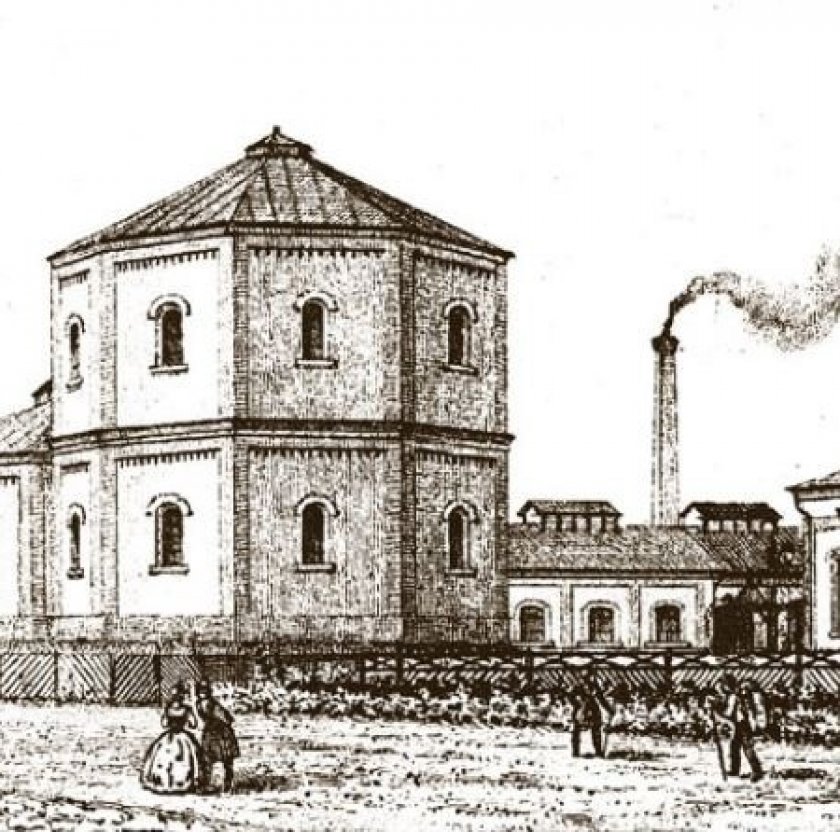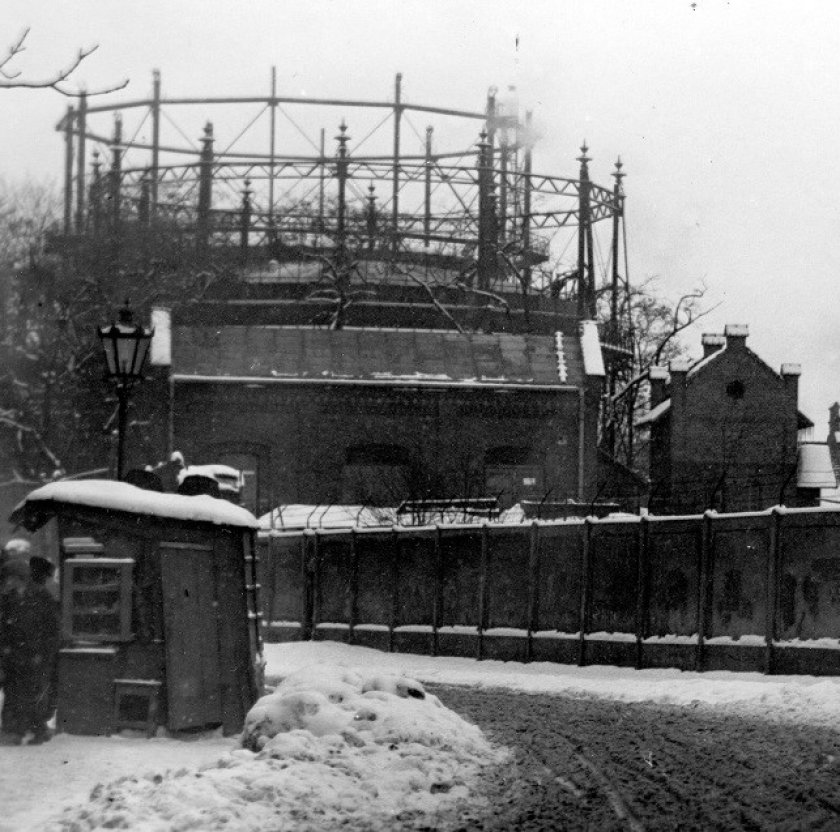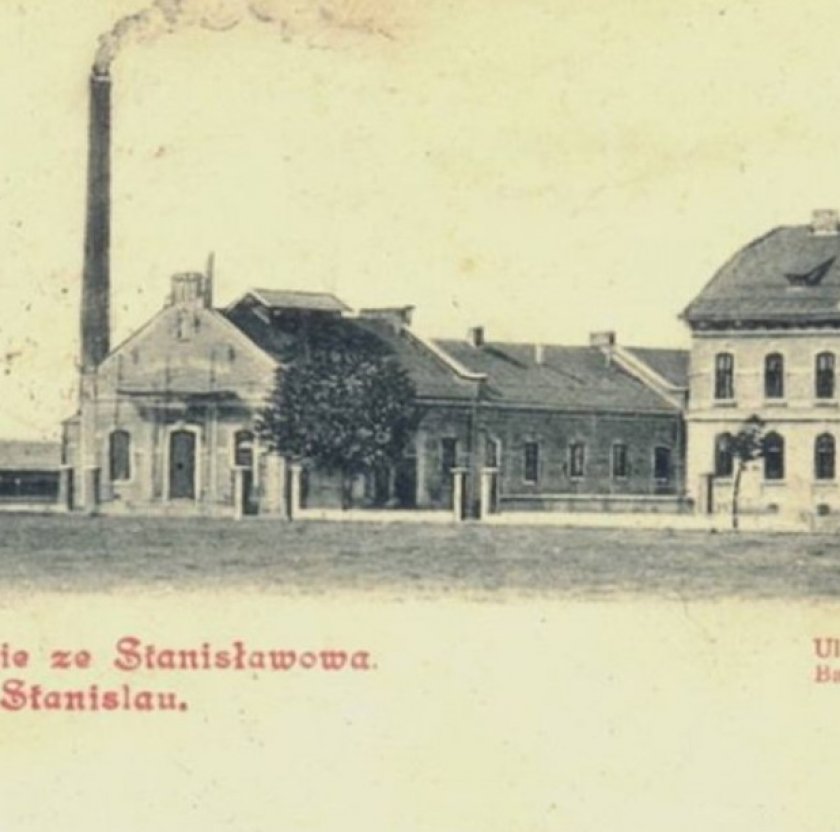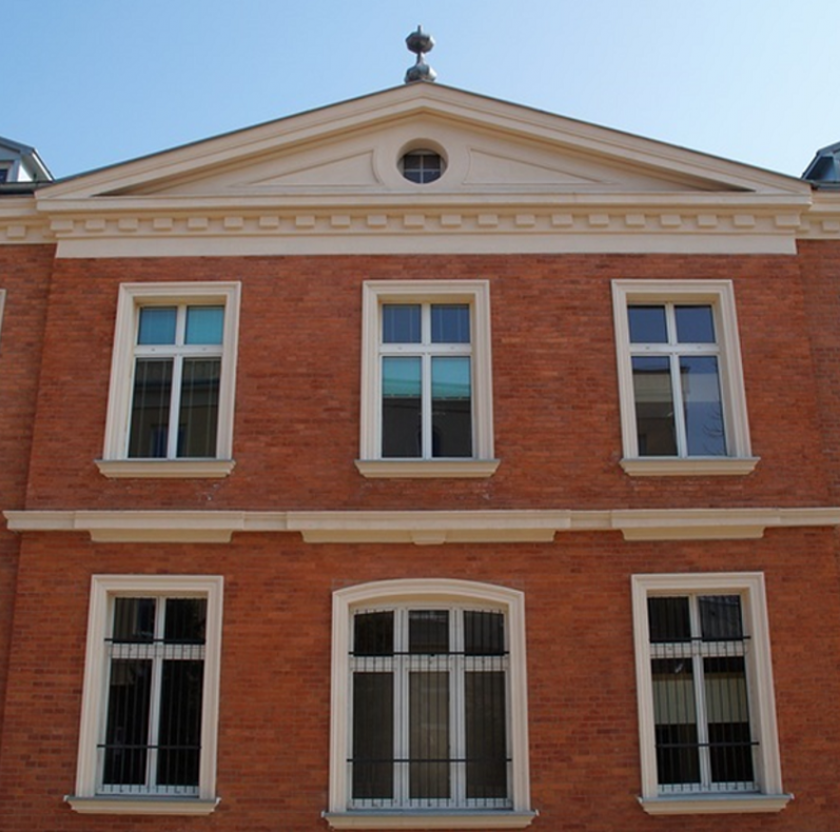History of the Bielsko-Biała Gasworks
 Fot.
Fot.
Let us not forget that these towns were divided by the Biała River, which separated Austrian Silesia from the Republic of Poland, and later Galicia, where Polish, German and Jewish languages and cultures intermingled. Owing to all this, Bielsko and Biała had a unique coexistence and a modern format.
This modern style could be seen in the construction of a modern urban infrastructure. The flagship investment of the authorities of Bielsko in the 19th century was the gasworks. Its origins date back to 1861. The decision to use gas lighting in Bielsko was taken by the city council on the initiative of the then mayor Karl Sennewald in January of the same year. Management of the planned gasworks was entrusted to the gas joint stock company (Bielitz-Bialaer Gasgesellschaft) established for this purpose.
The supervision of its work was assigned to a five-member supervisory board, which included representatives of local industry, as well as the director of the gasworks in the Czech Liberec, Rudolf Kühnell, and the princely administrator, Josef Preissler. The decision to establish the Company required the approval of the relevant administrative authorities. Given the fact that Bielsko belonged to Austrian Silesia, those authorities were located in Opava.
The supervision of its work was assigned to a five-member supervisory board, which included representatives of local industry, as well as the director of the gasworks in the Czech Liberec, Rudolf Kühnell, and the princely administrator, Josef Preissler. The decision to establish the Company required the approval of the relevant administrative authorities. Given the fact that Bielsko belonged to Austrian Silesia, those authorities were located in Opava.
After obtaining regulatory approval, the Company issued 1,200 shares at a price of 100 Austrian gulden each. In this way, the Company planned to obtain 120,000 gulden, which was to fully cover the construction costs of the gasworks. The company took on the obligation to supply gas to Bielsko, Biała and the Galician Lipnik for the next 80 years.
Alongside the scrambling for funds, negotiations continued with Rudolf Kühnell on the design of the gasworks. The negotiations ended successfully in the spring of 1861. On 30 April, a contract was concluded for the construction of the gasworks. The contractor for the works was a local firm owned by Karl Starke. After several months of intensive work, the investment in the Dolne Przedmieście area was completed. In mid-December 1861, the plant was officially opened. In the following days, the first lanterns powered by gas produced in the Bielsko gasworks were lit.
Alongside the scrambling for funds, negotiations continued with Rudolf Kühnell on the design of the gasworks. The negotiations ended successfully in the spring of 1861. On 30 April, a contract was concluded for the construction of the gasworks. The contractor for the works was a local firm owned by Karl Starke. After several months of intensive work, the investment in the Dolne Przedmieście area was completed. In mid-December 1861, the plant was officially opened. In the following days, the first lanterns powered by gas produced in the Bielsko gasworks were lit.
Over the next few years, the management of the company and the gas joint stock company held talks with the Bielsko city authorities. The fate of the gasworks actually depended on the success of these negotiations. The contract for gas supply to Biała was concluded in February 1865. The signatories to the transaction were the president of the Bielitz-Bialer Gasgesselschaft, Josef Preissler, and the mayor of Biała, Antoni Samesch. The signed agreement influenced the decision to expand the Gasworks so that its production could meet the growing demand in both towns.
To recapitalise the Company and raise investment funds, an additional 300 shares were issued. The Company's primary objective was achieved, the gasworks was expanded and modernised. The efforts made made it possible to increase the gas production capacity. In 1875, the gasworks supplied gas to 141 gas lamps installed in Bielsko. Fifteen years later, their number rose to 300.
To recapitalise the Company and raise investment funds, an additional 300 shares were issued. The Company's primary objective was achieved, the gasworks was expanded and modernised. The efforts made made it possible to increase the gas production capacity. In 1875, the gasworks supplied gas to 141 gas lamps installed in Bielsko. Fifteen years later, their number rose to 300.
The town of Biała, which focused largely on the development of electric lanterns, had lower demand. Nevertheless, in the 19th century, 66 gas lamps were installed in Biała. After World War II, there were still over 550 gas lamps operating in Bielsko. The last ones were dismantled in 1964. For many years, they were handled by lamplighters. It was not until 1936 that modern clock mechanisms were used. However, their life was rather short, as they were dismantled after 1939.
The gas lamps in Bielsko used Auer burners. Along the main traffic routes, the street lamps were fitted with quadruple lighting points. According to Aleksander Krzemień, the author of an unpublished work on the gasworks in Bielsko-Biała, in order to maximise the efficiency of the street lamps, they were spaced at distances of 15 to 25 metres. The decision on the spacing depended on the significance of a specific traffic route.
The gas lamps in Bielsko used Auer burners. Along the main traffic routes, the street lamps were fitted with quadruple lighting points. According to Aleksander Krzemień, the author of an unpublished work on the gasworks in Bielsko-Biała, in order to maximise the efficiency of the street lamps, they were spaced at distances of 15 to 25 metres. The decision on the spacing depended on the significance of a specific traffic route.
Founded in 1861, the gas joint stock company survived until 1902, when it was liquidated. On 1 July 1902, the gasworks became the property of the municipality of Bielsko. The municipal authorities established a new entity registered under the name Gazownia Miejska [City Gasworks]. Direct control of the works was taken over by a board of commissioners appointed by the Magistrate.
At this point, it is worth asking the legitimate question of what caused the company, which according to its statute, was supposed to operate for 80 years, to survive for barely half of that time? The change of ownership was most likely a result of a comprehensive upgrade of the gasworks as well as the production and storage facilities planned at the time. Upgrading the plant was necessary, as the existing one had a limited capacity. Investment costs seemed to exceed the company's resources. In such circumstances, the only option to expand the company was for it to be taken over by the city.
At this point, it is worth asking the legitimate question of what caused the company, which according to its statute, was supposed to operate for 80 years, to survive for barely half of that time? The change of ownership was most likely a result of a comprehensive upgrade of the gasworks as well as the production and storage facilities planned at the time. Upgrading the plant was necessary, as the existing one had a limited capacity. Investment costs seemed to exceed the company's resources. In such circumstances, the only option to expand the company was for it to be taken over by the city.
Another transformation of the City Gasworks (German: Städtisches Gaswerk) took place almost 30 years later. From January 1933, it became part of the Municipal Gas and Water Works. This restructuring was dictated by economic considerations (a crisis in municipal finances caused by the economic depression) and the search for savings in the administrative branch.
In the years of World War II, the occupation authorities led to the merger of the three most important municipal plants in Bielsko-Biała: the power plant, the gasworks and the waterworks. After the war, the previous state of affairs was restored and the Municipal Gas and Water Works was separated from the power plant. By the 1960s, several more transformations of the gasworks within municipal structures had taken place.
In the years of World War II, the occupation authorities led to the merger of the three most important municipal plants in Bielsko-Biała: the power plant, the gasworks and the waterworks. After the war, the previous state of affairs was restored and the Municipal Gas and Water Works was separated from the power plant. By the 1960s, several more transformations of the gasworks within municipal structures had taken place.
The breakthrough came in 1966, when the central authorities in Warsaw decided to place the Bielsko-Biała gasworks under the supervision of the Ministry of Mining and Energy. Consequently, the independent Bielsko-Biała Gasworks became part of the Upper Silesian District Gasworks with its headquarters in Zabrze. At the same time (since the 1950s), industrial consumers were switching to natural gas. This was the result of connecting the municipal gasworks to the long-distance network. In 1968, gas supply in Bielsko-Biała was already 19.3 million cubic metres. The length of gas pipelines was approximately 125 km.
Since 2000, Bielsko-Biała has belonged to the Zabrze Branch of the Upper Silesian Gasworks (since 2003 Górnośląska Spółka Gazownictwa [Upper Silesian Gas Company] which is part of the PGNiG Group). Since 2013, following the merger of regional distribution companies, the gasworks has been part of Polska Spółka Gazownictwa sp. z o.o.
Since 2000, Bielsko-Biała has belonged to the Zabrze Branch of the Upper Silesian Gasworks (since 2003 Górnośląska Spółka Gazownictwa [Upper Silesian Gas Company] which is part of the PGNiG Group). Since 2013, following the merger of regional distribution companies, the gasworks has been part of Polska Spółka Gazownictwa sp. z o.o.
At this point, it is worth devoting a few sentences to the technological solutions adopted at the Bielsko-Biała gasworks. In the initial period of its operation, furnaces with Liegel-type generators were used and a steam-driven suction unit was supplied by the Berlin Anhalter Maschinenbau Gesselschaft. As evidence of its efficiency, it was used at the gasworks until 1967.
Gas production in Bielsko at that time (according to data for 1875) averaged around 387 thousand cubic metres per year. Ten years later it was already 654,200 m3 of fuel. The production capacity of the Bielsko-Biała gasworks is clearly illustrated in the chart below. A cursory reading of the report reveals that the peak in gas production came in the years 1900-1920, when in a relatively short period of time there was an increase in production of almost one million 700 thousand m3 (by 158%).
Gas production in Bielsko at that time (according to data for 1875) averaged around 387 thousand cubic metres per year. Ten years later it was already 654,200 m3 of fuel. The production capacity of the Bielsko-Biała gasworks is clearly illustrated in the chart below. A cursory reading of the report reveals that the peak in gas production came in the years 1900-1920, when in a relatively short period of time there was an increase in production of almost one million 700 thousand m3 (by 158%).
![Gas production in the Bielsko gasworks between 1862 and 1940 [in m3 thous.]. State Archive
in Katowice/Division in Bielsko-Biała, complex: Gasworks, ref. 1: A. Krzemień, History of
the Gasworks of the City of Bielsko-Biała, Bielsko-Biała 1992. Gas production in the Bielsko gasworks between 1862 and 1940 [in m3 thous.].](/media/article_block/wykres-bielsko_image.JPG)
Gas production in the Bielsko gasworks between 1862 and 1940 [in m3 thous.]. State Archive
in Katowice/Division in Bielsko-Biała, complex: Gasworks, ref. 1: A. Krzemień, History of
the Gasworks of the City of Bielsko-Biała, Bielsko-Biała 1992.
The inter-war years saw a slowdown in this trend (1930) due to the progressing economic crisis, and finally a short but marked stagnation (1940) caused by the outbreak of World War II. In 1900, following the modernisation of the plant, a bell-shaped gas tank with a capacity of 2100 m3 was added. Even before World War I, a wet concrete gas meter from Pintsch, a pressure regulator with a capacity of 2300 m3/h, and four hydrogen sulphide gas purification boxes were installed in the gasworks.
Soon more changes at the gasworks were made. These took place between 1914 and 1916. This time half measures were not enough, and the gasworks was completely redeveloped. Most notably, a new hall with furnaces and a coal tower were constructed. A power station equipped with two Otto combustion engines as well as two DC generators was built in the ground floor.
Soon more changes at the gasworks were made. These took place between 1914 and 1916. This time half measures were not enough, and the gasworks was completely redeveloped. Most notably, a new hall with furnaces and a coal tower were constructed. A power station equipped with two Otto combustion engines as well as two DC generators was built in the ground floor.
The gasworks was also equipped with new coke bins and a drum coke sorting plant, as well as two concrete coal bins with a capacity of 100 tonnes each and one coke breeze bin. The furnace hall itself housed four vertical-retort furnaces, each with three double retorts. The furnaces were modernised in the late 1920s and early 1930s, when Didier installed three vertical-chamber furnaces in the furnace hall.
The gasworks in Bielsko (now Bielsko-Biała) was one of the most advanced in the Habsburg monarchy in the 19th and early 20th century. It is also regarded as one of the oldest in Poland. Before Bielsko and Biała, only a few cities had their own gasworks, including the most important and largest ones such as Kraków, Lviv, Poznan and Warsaw.
The gasworks in Bielsko (now Bielsko-Biała) was one of the most advanced in the Habsburg monarchy in the 19th and early 20th century. It is also regarded as one of the oldest in Poland. Before Bielsko and Biała, only a few cities had their own gasworks, including the most important and largest ones such as Kraków, Lviv, Poznan and Warsaw.



